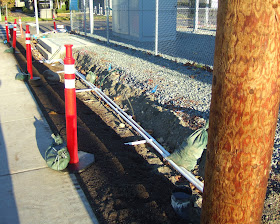I came across a couple of blow down trees that had been cut in order to reopen the road that they blocked. Both trees were Douglas fir and the site was on the dryer, western part of Orcas Island. Both trees were growing in very thin to almost non existent soil over Turtleback Complex bedrock. Knowing how old trees are can be helpful in evaluating slopes. In this case the trees were not really important for that purpose, but for other reasons I was curious about the age of the trees so I did tree ring counting.


As can be seen the rings were very tightly spaced particularly that outer band shown above, but a mid section band was also very closely spaced. I ended up with a count of 220. The tree was much older than I had initially expected at first glance. The modest size by old age reflects the rather harsh growing conditions. The tree was growing out of bedrock with very little soil. Something to consider when trying to estimate the age of trees by girth alone. A few weeks ago I was in a forest of much larger Douglas fir and that stand of trees was less than 60 years old.
No much soil under those roots.
The forest where this tree was located is nearly all Douglas fir, but the trunk sizes varied suggesting a very mixed age. I did observe a few madrones which would suggest the forest canopy may have been more open in the past, but this forest was fairly open even now. Underbrush was very thin and it was easy to move through this forest with a moss dominated floor and very thin brush. All over very thin soils and fractured hard bedrock and solid bedrock - not much in the way of glacial related sediment at this location.
Take a close look at the tree lying on the floor of the forest. This is an old blow down, but it is still very much alive. Two of its limbs have become leaders growing as straight trees out of the trunk. This is a Douglas fir feature I have observed at several other locations on Orcas Island including some spectacular examples on Turtleback Mountain
(selection-of-trees-on-orcas-island).
Elsewhere on Orcas I have observed very massive Douglas firs much bigger the 220 year old tree. Hence, I am now very curious about the age of those giants some of which are located on sites with very harsh growing conditions.
This blow down tree has a bit of a story to tell. One thing it shows is that at least at this site the area was not clear cut logged. Historically the San Juan Islands were known for not having particularly good timber relative to much of the rest of western Washington. This particular blow down tree seemed to be straight and not very limby. Perhaps its inland location and challenging site to move logs preempted this forest from being clear cut. The tree also had survived pre European/American land management - it had not been burned by fire. I did not observe any indication of past burn scars anywhere in this particular forest stand.
From a forest species perspective, the dominance of Douglas fir at this location dating back over 200 years is a bit different than nearby forest stands where lodge pole pine (locally called shore pine) are well represented as well as stands of junipers and oaks.
As for the bedrock of this forest. The rocks are part of the Turtleback Complex named for Turtleback Mountain on the west side of Orcas Island. Not supper exciting rocks to look at, but these rocks are very old and have a story to tell for those willing to extract the story out of them via microscopic mineral work and careful measurement of element isotopes.
A bit of Turtleback with the edge of a rock hammer on the right
Turtleback with faint mineral gneiss-like mineral alignment and green minerals (epidote?) with Douglas fir needle for scale.
The Turtleback Complex is one of several tectonic terranes in the Northwest Cascades System-San Juan mélange. Units within the mélange consist of a wide variety of low-grade to high-grade metamorphic rocks of various ages juxtaposed along now extinct tectonic fault lines. The terrains are slices of ocean floor, island arcs and possibly in some cases slices of terrane broken off of other continents and then accreted to the North American western margin via plate tectonic movements.
The Turtleback Complex is the oldest terrain in the San Juan mélange and has been correlated with similar very old rocks in the Northwest Cascades, the Yellow Aster Complex. Vance (1975) suggested the Turtleback was continental. The Turtleback contains a range of igneous rock types with intrusive cross cutting relationships, and I have found a fair bit of variety across the various locations I have encountered the Turtleback. Age of the intrusive rocks have been reported ages ranging from 554 Ma to 460 Ma (Whetten and others, 1978 and Brandon and others, 1988). This a very old terrane and plate tectonics does have some mind bending puzzles and correlating long traveled old terranes with their homeland will take considerable work.

































.jpg)















